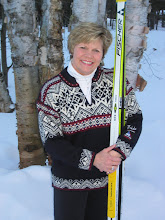When we woke up to fresh snow out our window we wasted no time getting up the mountain to ski. No lingering breakfast or time on the internet; it's a powder day!
Graciela called Henrique and for 40 pesos he took us up to Cerro Catedral in his citroen. The road had been plowed but was still slushy. Arriving at the base we could tell it was going to be a powder day. The snow was wet and heavy and the sky hung around our shoulders. Still, you could sense the excitement generated by fresh snow and we were at the front of the line.
Lift tickets were 150 pesos each and a reminder if you are using a credit card, bring your passport for identification.
We had some trouble finding a place to change out of our shoes into ski boots, but after a bit of struggle and sign language a friendly ski instructor guided us into a rental shop where we could use the bench and. . .thankfully, the toilet.
Folks will tell you the world speaks English. Don't believe them. Learn as much of the language as you can. "Where is the bathroom?" is a good start. We never heard English spoken, nor did we see any signs in English.

Even more foreign, we didn't notice trail maps or signs pointing out the runs for beginner, intermediate or advanced. Tomorrow our tour begins and we will ski with our Casa guide, Craig Ross. Anxious to glide, we couldn't wait. Today would be an adventure all on our own. Ron and I looked at each other, tightened down our boot buckles, hopped on the first chair we came to. . .and dove into skim milk.

Our first rides up were on double chairs, Princess I & II. They are slow and old, but we weren't in a hurry. The chairs ride over some incredible waterfalls that seemed to be running with gusto. Snow was adding up by the minute. Visibility--even if I could keep my goggles from clogging with snow--was nil. No lifts were open higher up the mountain and it looked like the slopes were only skier and snowboarder groomed. Still, there were skiers everywhere, mostly young people on vacation from school. They were having a ball and so were we.

Whiteout is always tricky on your balance--especially when you haven't been on skis for 4 months--but not knowing the terrain, language, or where we could end up on a narrow little cat track made us feel like aliens. Yoopers are tough to turn away, though. We weren't about to call it quits and I was thinking of all the young kids on the mountain who were obviously beginners and maneuvering through the tough terrain too. Hats off. They would go home with a story to tell, and hopefully a love for gliding on snow. That's why we live to ski and not go bowling.
We finished the day soaked to the gills but happy as two otters born to glide.

Until today I had skied every month of the year except August. And now I have 4 out of 7 continents under my skis: North America, Europe, Asia, and South America. Only 3 more to go: Africa, Australia, and Antarctica. It's doable. But first to learn more about these triple AAA's--Amazing Andes of Argentina. You're right Bernie!



















